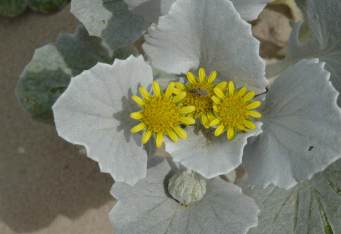Arctotheca populifolia
Arctotheca populifolia (Bergius) Norlindh
Family: Asteraceae
Common names: beach pumpkin (Eng.); seepampoen, tonteldoek (blom), strandgousblom (Afr.)
Introduction
Arctotheca populifolia is a 'beach bum'! It is a common pioneer along the southern African coast. Have a look next time you are on the beach and see if you can spot these obvious silvery grey-leaved colonies of plants on the foreshore dunes.

Description
Description
Arctotheca populifolia is an annual or perennial, creeping, mat-forming herb, up to 200 mm high. Leaves are large, heart-shaped with short stalks, slightly succulent, with a dense covering of white hairs, margins smooth to shallowly dentate.
The yellow flower heads are about 30 mm in diameter, borne on short, stout, curving stems and often overtopped by the large leaves. The green involucral bracts form a cup in several rows. The ray florets are bright yellow and widely spaced and the central flowers are greenish yellow.
Arctotheca populifolia generally flowers in the rainy season of any particular area, but because of the wide distribution, flowering times are recorded for all months of the year.
Conservation Status
Status
Because of the abundance and wide distribution area, this species is not threatened and is categorized as Least Concern.

Distribution and habitat
Distribution description
Arctotheca populifolia is common along the southern African coastline, from Hondeklipbaai along the West Coast right up to the southern Mozambique coast. It grows in deep sand on coastal dunes and around estuaries.
Derivation of name and historical aspects
History
The genus name Arctotheca is derived from the Greek words arcto for bear, and theca for a case or capsule. The name refers to the densely woolly fruit. The specific epithet populifolia refers to the leaves, which resemble those of a poplar tree.
There are five species of the genus Arctotheca found in South Africa, namely: A. calendula, A. forbesiana, A. marginata, A. prostrata and A. populifolia.
Ecology
Ecology
Flowers are pollinated by a variety of bees and flies. The parachute seeds are generally dispersed by wind but also remain viable in salt or fresh water and can therefore be dispersed by ocean currents.
Uses
Use
Arctotheca populifolia is a strong, tough plant and valuable for holding sand; therefore very useful as a ground cover in coastal gardens and as a dune stabilizer. It can be planted for the attractive foliage rather than for the flowers. However, the flowers provide food and nectar to a variety of bees, flies, butterflies and moths and can bring insects into the garden.
(Arctotheca calendula is known to be a strychnine antidote and a narcotic. It was also reported to have caused diarrhoea in sheep.)
It has been reported that the felt on the leaves can be useful as tinder to start a fire, if you are desperate to have a beach braai (barbecue).

Growing Arctotheca populifolia
Grow
Little is known about the cultivation of Arctotheca populifolia. Daisies generally have parachute seeds. The parachutes (pappus) should be cleaned off to improve the seeds' ability to absorb moisture. Sow the seeds in seed trays and lightly cover with a thin layer of seedling mix, which can include: coconut palm fibre, coarse river sand, loam or topsoil, milled pine bark, and fertilizer or manure.
Soft-tip cuttings can be made in spring and during the growing season. Use a medium strength rooting hormone and river sand as a rooting medium. Rooting should take about a month after which plants can be transplanted into pots in a well-drained, sandy potting mixture.
Remember that the natural habitat of Arctotheca populifolia is along the coast where the plants are exposed to cool sea breezes, fog and mist. Good ventilation is important. Plants in bags can easily suffer from heat. Soil from the original habitat also helps to inoculate the potting mixture with soil organisms, which promote healthy growth.
( Growing information contributed by Liesl van der Walt)
References
- Le Roux, A. 2005. Namaqualand. South African Wild Flower Guide 1. Botanical Society of South Africa, Cape Town.
- Leistner, O.A. (ed.). 2000. Seeds plants of southern Africa : families and genera. Strelitzia 10. National Botanical Institute, Pretoria.
- Manning, J. & Goldblatt, P. 1996. West Coast. South African Wild Flower Guide7. Botanical Society of South Africa, Cape Town.
- Moriarty, A. 1982. Outeniqua, Tsitsikamma and eastern Little Karoo. South African Wild Flower Guide 2. Botanical Society of South Africa, Cape Town.
- Mustart, P., Cowling, R. & Albertyn, J. 1997. Southern Overberg. South African Wild Flower Guide 8. Botanical Society of South Africa, Cape Town.
- Nichols, G. 2005. Growing rare plants: A practical handbook on propagating the threatened plants of southern Africa. Southern African Botanical Diversity Network Report No. 36. SABONET, Pretoria.
- Pooley, E. 1998. A field guide to wild flowers of KwaZulu-Natal and the Eastern Region. Natal Flora Publications Trust, Durban.
- Watt, J.M. & Breyer-Brandwijk, M.G. 1962. The medicinal and poisonous plants of southern and eastern Africa, edn 2. Livingstone, Edinburgh.
Credits
J. Mnengwane & M. Koekemoer
National Herbarium, Pretoria
February 2007
Plant Attributes:
Plant Type: Ground Cover, Perennial
SA Distribution: Eastern Cape, KwaZulu-Natal, Northern Cape, Western Cape
Soil type: Sandy
Flowering season: Sporadic/All year
PH: Alkaline
Flower colour: Yellow
Aspect: Full Sun
Gardening skill: Average
Special Features:
Horticultural zones








Rate this article
Article well written and informative
Rate this plant
Is this an interesting plant?
Login to add your Comment
Back to topNot registered yet? Click here to register.